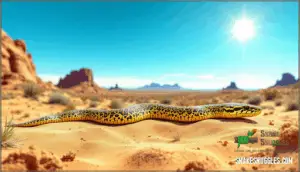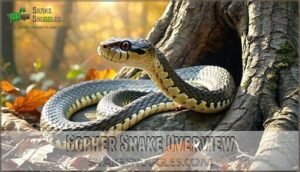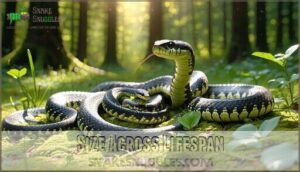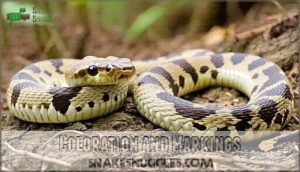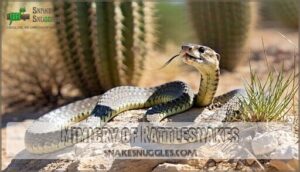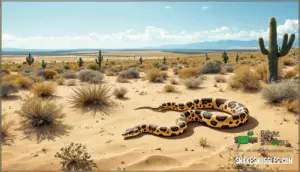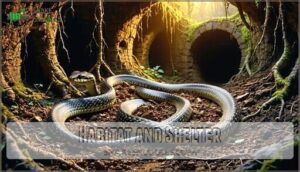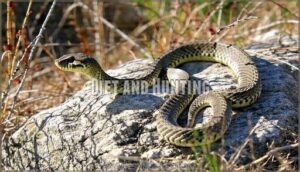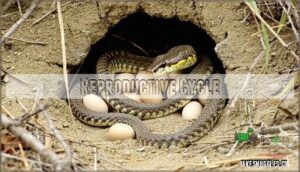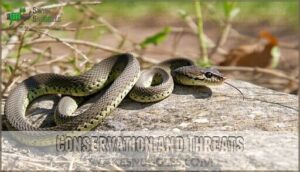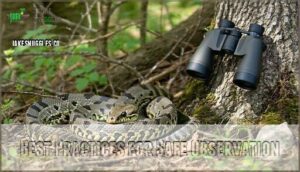This site is supported by our readers. We may earn a commission, at no cost to you, if you purchase through links.
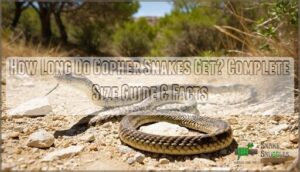
Their size varies somewhat by subspecies and geographic location, with Pacific gopher snakes often growing larger than their desert cousins.
These non-venomous serpents start small as hatchlings at just 12 to 18 inches, then grow steadily throughout their lives.
These substantial snakes rank among North America’s bigger non-venomous species, making them quite the sight when you encounter one in the wild. Their impressive length serves them well for their unique hunting style and defensive behaviors, and they are quite a sight with their unique hunting style.
Table Of Contents
- Key Takeaways
- How Long Do Gopher Snakes Get?
- Gopher Snake Overview
- Size Across Lifespan
- Identifying Gopher Snakes
- Geographic Distribution
- Habitat and Shelter
- Behavioral Traits
- Diet and Hunting
- Reproductive Cycle
- Conservation and Threats
- Observing Gopher Snakes in The Wild
- Frequently Asked Questions (FAQs)
- What time of day do gopher snakes come out?
- Do gopher snakes stay in one area?
- Are gopher snakes good to have in your yard?
- What is the typical lifespan of a gopher snake?
- How often do gopher snakes hibernate?
- What is the average size of a gopher snake’s eggs?
- What are the common predators of gopher snakes?
- How do gopher snakes defend themselves against predators?
- Do gopher snakes keep growing throughout life?
- What factors affect gopher snake growth rates?
- Conclusion
Key Takeaways
- You’ll find adult gopher snakes typically reach 3-5 feet long, though exceptional specimens can grow up to 7 feet, making them among North America’s larger non-venomous species.
- Your encounter with a hatchling will show they start small at just 11-16 inches but grow rapidly, doubling their birth size within the first year and reaching maturity by age 3-4.
- You’ll discover their size varies significantly by subspecies and location – Pacific gopher snakes often grow larger than desert populations, with bullsnakes holding the record as the biggest variety.
- You can expect these snakes to continue growing throughout their 10-15 year lifespan, though growth slows dramatically after reaching sexual maturity around their third year.
How Long Do Gopher Snakes Get?
Gopher snakes typically grow between 3-7 feet long, though exceptional individuals can reach 9 feet.
Most average around 4-5 feet at maturity.
These snake length variations depend on several size factors including subspecies, habitat quality, and genetics.
Growth patterns show rapid development in the first three years, then slow considerably.
The bullsnake subspecies holds length records as the largest variety.
Age measurements reveal they continue growing throughout their 10-15 year lifespan, making gopher snake maximum length highly variable within their natural size range.
Gopher Snake Overview
You’ll find gopher snakes are fascinating reptiles that belong to the genus Pituophis and go by several common names including bull snakes, pine snakes, and Pacific gopher snakes depending on their location.
These non-venomous constrictors have earned their reputation as excellent rodent controllers, featuring sturdy bodies with distinctive patterns that often cause people to mistake them for their venomous rattlesnake cousins.
Taxonomy and Common Names
In the context of Species Classification, you’ll find gopher snakes belong to the scientific family Pituophis catenifer.
These remarkable serpents earned their Common Names from their talent for hunting gophers and other burrowing rodents.
Understanding Snake Taxonomy helps you appreciate their role in North America’s ecosystem.
Gopher Identification becomes easier when you know their classification details:
- Scientific name: Pituophis catenifer (Pacific gopher snake)
- Family: Colubridae (non-venomous constrictors)
- Order: Squamata (scaled reptiles)
- Regional names: Bull snake, pine snake, blow snake
- Subspecies Variation: Six distinct subspecies across North America
Each subspecies shows unique traits in gopher snake size and coloration patterns, making identification an exciting challenge for wildlife enthusiasts.
Physical Description
You’ll recognize a gopher snake by its distinctive body shape and impressive size range.
These powerful constrictors showcase remarkable color variations from cream to dark brown with distinctive blotched patterns.
| Physical Feature | Description |
|---|---|
| Body Shape | Slender, sturdy build with keeled scales |
| Scale Patterns | Dark blotches on back, smaller spots on sides |
| Color Variations | Cream to dark brown base with gray sides |
| Head Structure | Large, triangular head with narrow neck |
| Eye Characteristics | Round pupils with distinct facial lines |
Adult gopher snake length typically ranges 3-7 feet, though some reach 9 feet.
Their impressive gopher snake size and triangular heads often cause mistaken identity with rattlesnakes, but their round pupils and lack of heat-sensing pits distinguish them as harmless constrictors.
Size Across Lifespan
You’ll watch gopher snakes grow from tiny 11-15 inch hatchlings into impressive adults that can stretch 3-9 feet long.
Their growth follows a predictable pattern, with most reaching their full size potential by their third or fourth year of life, which is a significant aspect of their growth.
Hatchling Measurements
When you first encounter a baby gopher snake, you’ll notice they’re surprisingly small but perfectly formed.
These hatchlings measure between 11-16 inches at birth size, already displaying the distinctive patterns they’ll carry into adulthood.
Here’s what you can expect from neonate care and juvenile development:
- Hatchling length varies by subspecies – Pacific gopher snakes start smaller while bullsnakes begin closer to 16 inches
- Snake growth occurs rapidly – they’ll double their birth size within their first year
- Gopher snake size range expands quickly – from tiny neonates to impressive juveniles in just months
These newly hatched snakes don’t need parental care.
They’re born ready to hunt and survive independently, making their small stature even more remarkable when you consider their self-sufficiency.
Adult Length Range
As your hatchlings mature, you’ll see impressive adult growth with most gopher snakes reaching 3-7 feet.
The gopher snake size range shows remarkable length variance – some specimens grow beyond 8 feet, though this maximum length represents exceptional cases.
Your full grown gopher snake’s typical size depends on subspecies and environment.
| Size Category | Length Range | Common Examples |
|---|---|---|
| Small Adults | 3-4 feet | Young females, desert populations |
| Average Adults | 4-6 feet | Most wild specimens |
| Large Adults | 6-7 feet | Older individuals, bullsnakes |
| Exceptional | 7-9 feet | Record specimens, ideal conditions |
| Regional Records | Up to 105 inches | Museum documentation |
The gopher snake average length of 4-5 feet reflects typical field observations, while gopher snake body length can vary considerably based on age and habitat quality.
Gopher snakes are often found in areas with sandy soil conditions that support their burrowing behavior.
Identifying Gopher Snakes
When you encounter a gopher snake in the wild, you’ll notice its distinctive brownish or tan base color with dark blotches running down its back and smaller spots along its sides.
These non-venomous constrictors often fool people into thinking they’re rattlesnakes, but you can tell the difference by looking for round pupils instead of vertical slits and checking for the absence of facial heat pits and tail rattles.
Coloration and Markings
You’ll easily recognize gopher snakes by their distinctive coloration and markings that help them survive in the wild.
Their base color ranges from cream to brownish, creating natural camouflage across different habitats.
Key identifying features include:
- Base color: Cream to tan base color with dark brown blotches running down the back
- Pattern variations: Large dark spots along the spine with smaller markings on the sides
- Scale texture: Keeled (ridged) scales that give them a rougher appearance than smooth-scaled snakes
- Marking shapes: Rectangular or oval-shaped blotches that create a distinctive splotchy pattern
- Color morphs: Brownish coloration varies by region, with some populations showing more yellow or gray tones
These gopher snake markings aren’t random—they’re nature’s clever disguise system that helps these harmless constrictors blend into their surroundings.
Understanding their natural camouflage techniques is essential for identifying and appreciating these amazing creatures.
Mimicry of Rattlesnakes
Spotting gopher snake mimicry can save you from unnecessary panic during outdoor encounters.
These master impersonators use defensive posture and Batesian mimicry to fool predators and humans alike.
When threatened, they’ll flatten their heads, vibrate their tails against vegetation, and produce loud hissing sounds that rival any rattlesnake imitation.
| Feature | Gopher Snake | Rattlesnake |
|---|---|---|
| Tail Sound | Vibrates silently | Produces rattle |
| Head Shape | Flattens when threatened | Naturally triangular |
| Pupils | Round | Vertical slits |
| Heat Pits | Absent | Present near nostrils |
| Body Length | 3-9 feet | 2-5 feet typically |
Geographic Distribution
You’ll find gopher snakes across a massive range spanning from southern British Columbia and Saskatchewan down to northern Mexico, covering most of the western United States including Wisconsin and extending to the Pacific coast.
These adaptable reptiles thrive in diverse habitats from deserts and prairies to woodlands and agricultural fields, though they prefer well-drained soils and rarely venture above 2,000 feet elevation, making them a notable presence in various ecosystems, particularly where they can be found in agricultural fields.
North American Range
Gopher snakes span an impressive geographic scope across western North America, from southern British Columbia to northern Mexico.
You’ll find these adaptable serpents throughout California’s valleys, Arizona’s deserts, and Nevada’s Great Basin.
Their North American range extends from sea level to 7,000 feet elevation, showcasing remarkable habitat diversity.
Regional distribution includes Texas panhandle areas and New Mexico plains.
Climate variations don’t stop average gopher snake populations from thriving in coastal zones, agricultural lands, and sagebrush environments.
This extensive elevation limits and geographic spread makes gopher snake growth patterns vary across different regions, with a significant impact on their geographic scope and regional distribution, in various elevation ranges.
Habitat Preferences
Where you’ll find gopher snakes depends on their specific habitat preferences and geographic distribution.
These adaptable reptiles thrive across diverse environments, from desert habitats to grassland ecosystems, thanks to their remarkable environmental adaptations.
Their burrowing behavior suits various soil types perfectly.
You’ll spot them in:
- Desert Habitats – Sandy washes and rocky outcrops provide ideal shelter
- Grassland Ecosystems – Open prairies with loose, well-drained soils
- Agricultural Areas – Farmland offers abundant prey and suitable burrow depth
- Scrublands – Sparse vegetation allows easy movement and hunting
These snakes avoid dense forests, preferring areas where their geographical location supports effective burrowing up to several feet deep.
Habitat and Shelter
You’ll find gopher snakes are master burrowers, spending up to 90% of their time underground in dens they either dig themselves or take over from other animals.
These snakes have adapted perfectly to life below ground, using their burrows not just for shelter but as hunting headquarters where they can ambush unsuspecting rodents.
Burrowing Behavior
Gopher snakes’ subterranean lifestyle revolves around sophisticated tunnel systems that extend 3-4 feet underground. You’ll discover these serpents spend up to 90% of their time in carefully constructed burrows, which serve multiple purposes beyond simple shelter.
Their soil preference leans toward loose, sandy substrates that allow easy excavation and modification. These underground burrows provide essential escape routes from predators while offering prime hunting opportunities for rodents that share similar burrowing behavior, and are a key example of ecosystem engineering.
| Burrowing Aspect | Description | Purpose |
|---|---|---|
| Burrow Depth | 3-4 feet underground | Temperature regulation, protection |
| Tunnel Systems | Complex networks with multiple chambers | Hunting access, escape routes |
| Denning Habits | Communal winter shelters | Hibernation, energy conservation |
| Soil Preference | Sandy, loose substrates | Easy excavation, structural stability |
The burrows serve as a crucial part of the snakes’ ecosystem engineering, modifying their environment to create habitats that support other species, and their denning habits play a significant role in their survival during winter months.
Environmental Adaptations
You’ll discover that these snakes adapt beautifully to changing conditions through sophisticated thermal regulation and smart burrow architecture.
Climate change affects their gopher snake growth rate, but they respond by adjusting soil preference and seeking reliable water sources.
Their environmental impact remains positive as they control rodent populations.
Habitat availability influence determines gopher snake size and dimensions across different regions, making them remarkably resilient survivors.
The creation of suitable snake habitats often relies on proper snake habitat kits to mimic their natural environments, which is crucial for their natural environments.
Behavioral Traits
You’ll find that gopher snakes are surprisingly solitary creatures who prefer to keep to themselves rather than socialize with other snakes.
Their daily schedule shifts with the seasons – they’re active during daylight hours in cooler weather but switch to nighttime hunting when temperatures soar.
Solitary Nature and Territory
When you observe a gopher snake in the wild, you’ll quickly notice their preference for living alone. These reptiles embrace their Solitary Life with remarkable dedication, rarely seeking companionship outside of breeding season.
Each adult gopher snake claims its own Home Range, typically spanning less than a quarter mile. This Territory Marking isn’t done through scent like mammals might – instead, they establish dominance through presence and Territorial Behavior patterns. You won’t find multiple snakes sharing the same prime hunting grounds.
Understanding their solitary nature helps explain Snake Encounters you might have:
- Single sightings: You’ll rarely spot multiple gopher snakes together unless it’s mating season
- Defensive posturing: Alone snakes rely heavily on intimidation tactics when threatened
- Consistent locations: Individual snakes often return to the same shelter areas within their territory
The gopher snake dimensions and gopher snake size don’t influence their territorial needs much – even smaller individuals maintain their own space. This solitary nature guarantees adequate prey resources and reduces competition, contributing to their survival success across diverse habitats.
Diurnal and Nocturnal Activity
During warmer months, you’ll spot gopher snakes following daily cycles that shift between diurnal and nocturnal behavior.
Their activity patterns follow natural circadian rhythms influenced by light exposure and seasonal changes.
Adult gopher snakes, regardless of their impressive size, adjust their schedules based on environmental conditions, which helps them regulate body temperature effectively while maintaining essential hunting success throughout different seasons.
Understanding nocturnal snake behavior is vital to appreciating the nuances of gopher snake activity patterns, showcasing their behavioral flexibility.
Diet and Hunting
You’ll find that gopher snakes are skilled hunters who use their impressive length to their advantage when catching prey.
These powerful constrictors squeeze their victims to death, primarily targeting small mammals, birds, and rodents that make up the bulk of their diet.
Prey and Predation Methods
Gopher snakes excel at prey capture using proven constriction methods that work like a living rope.
When you watch them hunt, you’ll see ambush predation in burrows and active foraging during morning hours.
Their hunting tactics include tongue-flicking to track prey and lightning-fast strikes with 80% success rates.
These survival strategies involve wrapping 3-6 coils around victims, creating cardiovascular collapse within 60 seconds.
Their predator avoidance includes rattlesnake mimicry, while their diet spans rodents to birds, making gopher snake size comparison essential for understanding their hunting range.
Effective snake control often relies on snake trap systems to manage populations.
Dietary Variation by Size
As young gopher snakes mature, their prey selection shifts dramatically from tiny insects and lizards to substantial mammals like rabbits and ground squirrels.
This size variation directly impacts their feeding behavior and growth rate. Hatchlings focus on easily-caught prey, while adults can tackle gopher snake maturity size challenges by hunting larger animals.
Their nutrient intake improves with typical size increases, though they’ll still grab smaller meals when available. This dietary variation explains why gopher snake size comparison studies show such different growth patterns – it’s all about what fits in their mouth and provides the best energy return.
This understanding highlights the importance of considering the snake’s prey selection in studies of their development and behavior.
Reproductive Cycle
You’ll find gopher snakes reach sexual maturity between 1 and 4 years old, with mating season occurring in spring when males compete for females.
Females lay clutches averaging 15 eggs in early summer, which incubate for about 65 to 75 days before hatching into independent juveniles.
Mating Season
Spring marks the start of gopher snake mating season, typically running March through June.
You’ll find females releasing pheromones to attract males, who then compete through ritualistic wrestling matches for mating rights.
These snake courtship displays involve serious combat – males bite, pin, and overpower rivals to prove their fitness. Once a victor emerges, mating behavior begins with the male aligning alongside the female.
Copulation lasts 15-30 minutes as both snakes intertwine. This reproductive cycle helps maintain genetic diversity, with mate selection favoring the strongest males for peak breeding seasons.
Understanding the snake mating habits is vital for appreciating the complexity of gopher snake behavior.
Egg Laying and Incubation
After successful mating season, female gopher snakes begin egg formation in late spring.
They’ll select protected nesting sites like abandoned burrows or loose soil for favorable incubation conditions.
The reproductive cycle continues with these key stages:
- Clutch size: Females lay 2-24 eggs averaging 15 per clutch
- Incubation period: Eggs develop for 65-75 days at consistent temperatures
- Hatchling care: Young emerge independent, requiring no parental assistance
Breeding seasons influence timing, while nesting habits guarantee proper egg laying success rates.
Conservation and Threats
Gopher snakes maintain stable populations across most of their range, though they face pressure from habitat loss and human development.
You’ll find these adaptable constrictors threatened mainly by agricultural expansion, urban sprawl, and road mortality in areas where their territories overlap with human activity.
Population Status
Most gopher snake populations remain stable across North America, with over one million individuals estimated range-wide.
However, species conservation faces growing challenges from habitat loss and urban development.
In British Columbia, four populations show concerning fragmentation patterns, while the Great Basin subspecies faces threatened status with projected 30% population decline over 24 years.
Snake migration routes increasingly intersect busy roads, creating mortality hotspots.
Adult size varies by region, with Pacific and bullsnake subspecies reaching largest dimensions up to eight feet, while environmental impact continues reshaping local population trends nationwide, affecting the overall population decline.
Environmental Impact on Survival
Throughout their lifespan, these snakes face mounting environmental pressures that threaten their survival.
Climate change disrupts winter hibernation patterns, reducing snow cover that normally insulates their dens.
Habitat loss from urban development fragments their territories, limiting access to prey and shelter.
Poor soil quality affects burrowing sites, while reduced water availability impacts ecosystem balance.
Agricultural chemicals poison their food sources, creating deadly environmental impacts.
You’ll find these wildlife survival strategies increasingly challenged as human activities alter their natural world, making conservation survival strategies essential for maintaining healthy populations, and addressing the need for healthy populations and environmental pressures.
Observing Gopher Snakes in The Wild
Spotting these impressive snakes in their natural habitat requires patience and knowing where to look.
You’ll have the best chance of encountering gopher snakes in grasslands, agricultural areas, and open woodlands during their active hours in spring and early summer.
Best Practices for Safe Observation
You’ll want to maintain a respectful distance when observing gopher snakes in their natural habitat.
These non-venomous constrictors deserve your careful attention to wildlife safety protocols.
- Keep at least 6 feet away – even harmless species can bite defensively
- Never attempt snake handling – leave wildlife undisturbed for their protection
- Move slowly and quietly – sudden movements can stress these sensitive creatures
Following proper field guidelines guarantees safe viewing while respecting these fascinating reptiles that can reach impressive sizes up to 9 feet.
For ideal observation, using wildlife binoculars is essential for a safe and enjoyable experience.
Locations for Viewing
Now that you know how to safely observe these fascinating reptiles, let’s explore where you’re most likely to spot them. Gopher snake size by region varies substantially, making locations for viewing particularly exciting for enthusiasts.
Here are five prime locations for viewing gopher snakes:
- Desert Spots – Arizona’s Sonoran Desert offers excellent Pacific gopher snake and Sonoran gopher snake viewing opportunities
- Mountain Trails – Rocky Mountain foothills provide ideal habitat for larger subspecies
- Coastal Areas – California’s coastal regions host San Diego gopher snake populations
- Forest Floors – Pine and oak woodlands throughout the western states
- Prairie Lands – Great Plains grasslands support thriving bullsnake communities
You’ll find the largest specimens in warmer climates where prey is abundant year-round. Visit early morning or late afternoon when they’re most active. Understanding their natural habitats is vital for effective spotting and conservation efforts.
Frequently Asked Questions (FAQs)
What time of day do gopher snakes come out?
Like early morning joggers, gopher snakes are most active during daylight hours.
You’ll typically spot them hunting and moving around from dawn through late afternoon, though they’ll venture out at night during hot summer weather to stay cool, which can be considered their active time.
Do gopher snakes stay in one area?
Gopher snakes don’t wander far from home—they’re surprisingly territorial creatures with small ranges. You’ll typically find them sticking within a quarter-mile radius of their favorite burrow or den.
Are gopher snakes good to have in your yard?
Yes, gopher snakes are beneficial yard residents.
They’re non-venomous constrictors that control rodent populations by eating mice, rats, and gophers.
They’re generally harmless to humans and pets, making them natural pest controllers.
What is the typical lifespan of a gopher snake?
While wild gopher snakes face constant dangers and harsh conditions, they typically live 10-15 years. In captivity’s safety, they’ve reached over 33 years, showing their remarkable longevity potential.
How often do gopher snakes hibernate?
You’ll find these snakes don’t truly hibernate but enter brumation during winter months. They’ll retreat to underground dens or burrows when temperatures drop, becoming less active until spring warmth returns.
What is the average size of a gopher snake’s eggs?
You’ll spot eggs about 2 to 4 inches long, shaped like leathery jellybeans.
These eggs aren’t hard like chicken eggs, so don’t crack them for breakfast!
They incubate underground, safe from most curious critters, and this is a complete concept that shows they are protected.
What are the common predators of gopher snakes?
Fearsome foxes, fierce hawks, and crafty coyotes commonly hunt gopher snakes.
You’ll also find king snakes targeting them as prey, along with other raptors that spot them basking or moving across open ground.
How do gopher snakes defend themselves against predators?
When you encounter a gopher snake defending itself, you’ll see it hiss loudly, vibrate its tail against vegetation, and flatten its head to mimic a rattlesnake’s threatening appearance.
Do gopher snakes keep growing throughout life?
Like trees that never stop adding rings, you’ll discover that gopher snakes continue growing throughout their lives, though growth dramatically slows after reaching sexual maturity around three years old.
What factors affect gopher snake growth rates?
Temperature, climate, nutrition, and prey availability directly influence your gopher snake‘s growth rate. Warmer environments promote faster development, while adequate food sources guarantee healthy progression from hatchling to adult size.
Conclusion
Ever wondered how these impressive serpents stack up against other North American species.
Understanding how long do gopher snakes get helps you appreciate their role as accomplished predators. These remarkable reptiles typically reach 3-5 feet in length, with exceptional specimens growing up to 7 feet.
You’ll find their substantial size makes them effective hunters and formidable defenders. Whether you encounter one in the wild or consider them as educational subjects, knowing their size range enhances your understanding of these fascinating non-venomous snakes and their important ecological contributions.
- https://fieldguide.mt.gov/speciesdetail.aspx?elcode=aradb26020
- http://minnesotaseasons.com/Reptiles/gopher_snake.html
- https://www.burkemuseum.org/collections-and-research/biology/herpetology/amphibians-reptiles-washington/pacific-gopher-snake
- https://a100.gov.bc.ca/pub/acat/documents/r4159/whr_4477_rpica_1150409132744_7aa87b11e6fd408cb82fe3fd2bd99524.pdf
- https://ecotox.oehha.ca.gov/species/reptiles/lizards-and-snakes-squamata/gopher-snake-pituophis-catenifer-formerly-pituophis

